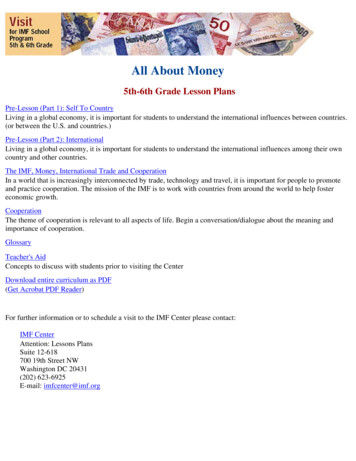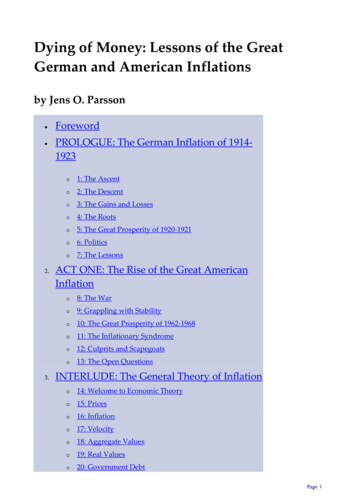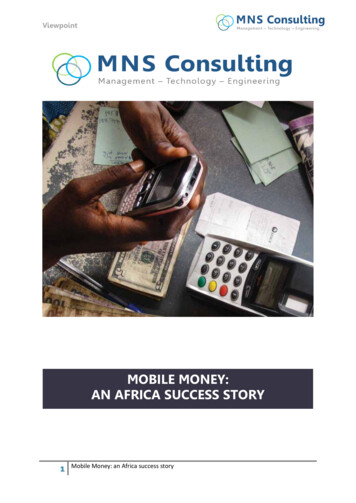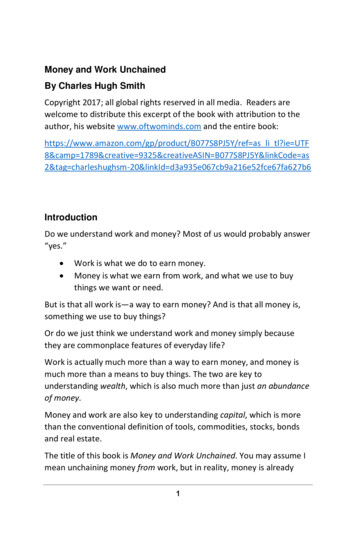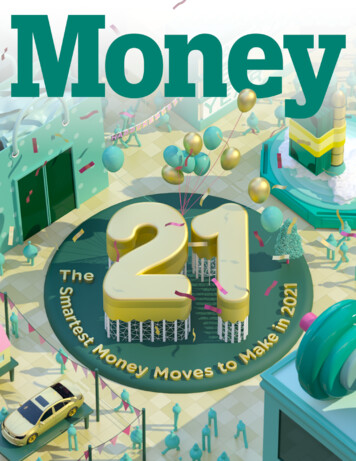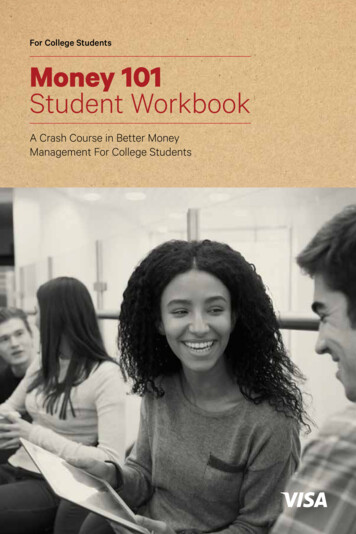
Transcription
For College StudentsMoney 101Student WorkbookA Crash Course in Better MoneyManagement For College Students
A Note to StudentsFor many students, going to college means living independently for thefirst time, which also means having to make new and sometimeschallenging financial decisions. Financial responsibility may be new to you— and even if it isn't, chances are you could still use a few pointers. Thepurpose of this workbook is to help you learn how to budget your money,as well as understand how financial services and products work so thatyou can take control of your financial future with confidence.Whether you are buying a car, renting an apartment, saving for a springbreak trip or building an emergency fund, this workbook is meant to be aguide to help you make wise financial choices. Some of these worksheetshave answers that come only from your personal experience, while otherworksheets require you do some studying before coming up with thecorrect answer.Why Now?College is a time for new experiences and freedoms, but also new responsibilities —especially when it comes to your finances.The earlier you start to create good habits with your money, the easier it will be to stickwith them, especially when you get older and financial decisions become even morecritical and complex. This workbook provides an opportunity to get a jump on becominga better money manager from day one, so that you can enjoy some of the most importantand memorable years of your life, free of undue financial stress.That's why Visa has put together this program. We want you to understand the basicsof managing money wisely. Our hope is that after you complete this workbook, you'llhave a better understanding of living within a budget, the nuances of banking and howto handle credit responsibly.Table of ContentsBudgeting Your MoneyTrack Your ExpensesMaking a PlanMonthly Expense TrackerBalancing Your BudgetWorksheet235689Online & Mobile BankingYour Money and Online BankingDigital Wallets101012Checking AccountCheck It OutGood Record-keeping141517Debit CardsDebit vs. CreditThings to Remember181819Savings AccountFor a Rainy DaySavings Worksheet202021Understanding CreditWhen Does Your Credit Score Matter?Meet TessMaking the GradeTypes of Student LoansStudent Loan RepaymentTax Savings Lessen the BlowDon’t Get In Over Your HeadKeep Your Eyes on the Fees222324252627282930Test YourselfGlossary of TermsOnline Resources3234Back CoverStudent Workbook 1
Budgeting Your MoneyBe the Master of Your MoneyIn order to manage your money, you need to have a plan. That is why creating a budget,and sticking to it, is a critical foundation for financial order and stability. By trackingyour income and expenses, you will be better able to distinguish between needs vs.wants.Know Your IncomeThe first step in this process is to know how much you make. Most college studentshave limited income. Figure out how much you have coming in each month, and thentrack your expenses. Use the chart below to track your monthly income. Make sureto only include income you can count on — no gifts or bonuses. To really get aheadof the game, before you budget your income, try to set aside 10% to 15% of it forlong-term savings.IncomeEstimated AmountActual AmountSalaryLoansGrantsScholarshipsMoney from ParentsOther IncomeTrack Your ExpensesTracking your expenses is a key step toward financial responsibility. Track your spendingfor a month with the worksheet in this workbook. Get receipts for everything and enterthe amounts into the worksheet each week. You'll be shocked by the way unplannedsmall purchases can add up. By making a habit of tracking your expenses, you can seewhere your money is going, which will help you curb your spending.Three Ways to Save, so youseveral tiers of meal plansFood: Most schools offer. If youyou without overspendingcan choose what's right forundexplore all of the stores aron,plaalmeaongyinrelaren'tgroceries.you for the best deals on50 per year,run may cost you over 8Coffee: That daily coffeepenses orck on these small daily exbagttinCu.tipingludincnotyou savee coffee maker could helppurchasing an inexpensivin the long run.nay used textbook rather thaTextbooks: Buying a gentlntedpriaofdg an e-book insteabrand-new one — or buyinbucks.textbook — can save bigTotalTotal IncomeTip: You can track your expensesusing personal finance budgetingapps, which make budgeting moreconvenient than ever.2 Student WorkbookStudent Workbook 3
Budgeting Your MoneyShare living expenseswith a roommate. It’sa great way to cutmonthly costs in half.Compare costs fromdifferent insurancecompanies.Make a list beforeshopping for groceries.It will help you avoidpricey impulse buys.Making a PlanTrack your expenses for a month on the worksheet on pages 6 and 7. Look at all ofyour expenses by category (living, school, personal, food, and other), estimate yourmonthly income, see what you’ve spent, and make a spending plan for the comingmonth. Tracking your expenses will allow you to find areas of discretionary (items youwant) vs. non-discretionary (items you need) spending where you can cut back andincrease your savings. (See example, opposite page.)Every month you should balance your budget to make sure that you’re not spendingmore than you’re making. Entertainment expenses can add up quickly in college, butthey’re also easy to cut back. Housing and utilities aren’t as easy. A personal budget isa work in progress, and spending within your budget will soon become second nature.Budgeting to Meet Your Goals Prioritize your savings goals Set short-term, medium-term and long-term goals Consider what you need to do to accomplish these goals within yourprojected time frameBudgeting AppsBudgeting apps allow you to link your bank account and separate your income intodifferent categories like rent, loans, groceries and entertainment costs. You can set abudget for each category to keep your expenses organized and controlled.Try to put money asidewhen you know bigexpenses like tuition andinsurance are coming up.4 Student WorkbookGo easy on the credit cards.High monthly payments cancramp your budget.minutes eachTip: Set aside 15your expensestathresuekaweek to mep with your onlinuginhtcamreaett and your budgnemteastknabis on track.Student Workbook 5
Budgeting Your MoneyMonthly Expense TrackerExpensesWeek 1ExpensesWeek 2Week TotalCar PaymentInsuranceMonthlyTotalMonthlyTotalMeal PlanDining ppliesOtherSchoolToiletriesGroceriesRepairsFees6 Student ternetMisc.Week 4EyesPrescriptionsCell PhoneFoodLivingCablePublic Trans.Week 3DentistUtilitiesMisc.Week 2DoctorWeek 4RentFurnishingsWeek 1MonthlyTotalCredit CardsSavingsMisc.MonthlyTotalTotalStudent Workbook 7
Budgeting Your MoneyBalancing Your BudgetCongratulations! The hard part is done. Once you get in the habit of tracking yourexpenses, you’re ready to start balancing your budget. Take a look at how muchyou’re spending every month in each category. You now have a picture of where yourmoney is going, so you can scrimp in one category if you anticipate needs in another.For example, if a great concert is coming to town, you can cut back on snacks or befrugal with groceries for a couple of days so you can go to the concert and enjoyyourself without exceeding your budget. You can also get a side hustle, like drivingfor a rideshare company, to supplement your income so you can make unplannedexpenses without blowing your budget.IncomeEstimated AmountActual AmountSalaryMoney from ParentsLoansGrantsScholarshipsOther IncomeTotalWorksheetThis budget worksheet will help you set up your personal budgeting system. Enteryour income and expenses in the first column. After a month, compare the totals toyour tracked expenses and income. How far off were you? If you’re spending beyondyour means, make adjustments, and track your spending again the next month.Total IncomeExpensesEstimated AmountActual alOtherTotalTotal ExpensesTotal Income–Total Expenses Net IncomeTo use our online Budget Planner,visit practicalmoneyskills.com/reworkbudget8 Student WorkbookStudent Workbook 9
Online & Mobile BankingTechnology: The Center of Our UniverseToday’s banking technology can help us more than ever before. One of the areas wheretechnology has been fully utilized is mobile and online banking. Now, just about everycustomer transaction can be completed on your mobile device. Checking balances,paying bills, tracking your spending, finding the closest ATM, transferring funds anddepositing checks can all be done in the palm of your hand. Mobile banking is becomingone of the most secure ways to pay and transfer money, especially with features likefingerprint technology.StatementsAnother useful feature is the ability to view your statements online. Even better, youcan view past statements too. It’s convenient, it’s paperless (saves trees) and it detersmail fraud and identity theft.Your Money and Online BankingOnline and mobile banking are convenient and valuable because they help keep youorganized. However, remember that it’s important to regularly keep track of debits anddeposits that may not have cleared yet on your online banking statement. You can alsomake fast, easy, cashless transactions with peer-to-peer payment service apps. Today’sfinancial institutions have sophisticated fraud protection services; however, the moreyou’re on top of your daily transactions, the faster you can identify any suspiciousactivity.Bill PayWith online banking, scheduling and paying bills on time makes tracking your expensesfast and efficient. You can easily list payees such as your landlord, cell phone provideror car insurance company. By identifying your payee name, address and account number(if applicable) you can send payments from your account almost instantaneously. If youchoose to, you can set it up to pay your bills automatically at a predetermined date orremind you when a payment is due. Many banks will have your bills sent to you onlinedepending on whether or not the payee offers electronic billing.Bill tracking apps allow you to link your bank account to pending bills so that you canpay your landlord or utility vendors with ease. You can pay your bills directly from theapp to avoid late fees and stay organized.10 Student WorkbookStudent Workbook 11
Online & Mobile BankingFunds TransferFrom a security standpoint, one of the best qualities of online banking is that it allowsyou to transfer funds electronically. Transfer money between your personal accountsand outside accounts, such as student or car loans, credit cards and sometimes othercontacts’ accounts — like your landlord’s. It may also allow your parents to send youmoney instantly. While there are many apps and payment services on the market, utilizingyour bank’s services is convenient and safe.Another way to develop a saving strategy is to automatically have a portion of yourpaycheck or checking account balance transferred into a savings account or investmentfund. You can typically set this up online or at your local branch or use an investmentsavings app.Digital WalletsApps also come in handy for making payments. Many services allow you to keep trackof your debit and credit cards digitally. A digital wallet allows you to make cashlesspayments from your cards through your phone. More stores are beginning to acceptthese payments.Online Banking BenefitsAvailable 24/7Email and mobileAccess from anyaccount alertsdeviceBudgeting tools andautomated spreadsheetsView, download and print onlinestatementsEasy fund transfersView images of checksLink to student loan informationMobility to accessaccounts onsmartphones andmobile devicesEnvironmentally friendly by makingelectronic, paperless transactionsBill pay feature can ensure thatbills are paid on time12 Student WorkbookStudent Workbook 13
Checking AccountGetting Started: Banking Options Available to StudentsTo open a checking or savings account, you can apply online or visit a bank's branchlocation. Once your account is opened, you’ll be able to enroll in online banking via thebank’s website and use your login information to download and start using the mobilebanking app. In any event, it’s a good idea to comparison shop for banks and look forminimal fees and the best interest rates on savings as well as all the tools andtechnology that suit your needs.Check It OutIt’s important for you to understand the building blocks of budgeting and online banking— your checking and savings accounts. Before you open accounts it’s important tounderstand basics about these accounts. Your checking account is the central hub foryour money. You can access it several different ways: checks, ATM, debit card, banksand online banking. Your savings account, which can also be accessed with your debitcard or at your banking center, is a great place to save for a rainy day or future expenses,like a car or tuition.ONLINE & MOBILECHECKING ACCOUNTtt Checklising AccounCheckDEBIT CARDCHECKSBANKATMonthlyr account mBalance youctionsmatic transaKnowle for autoyour scheduofKeep trackLook out forfeesturessecurity feamediatelys activity imiciouReport susp14 Student WorkbookCheck Safety and SecurityIf you are going outside of your bank to get checks printed, make sure you do yourhomework on a third-party check provider. A reputable check printer offers securityfeatures built into the check. Items to look for are a padlock icon on the printer’swebsite to the left of the web address, micro printing, security screen and warningboxes that appear on the front and back of the check. Do not put private informationon checks like your Social Security number, your driver’s license number or anyunnecessary personal data.Student Workbook 15
Checking AccountWriting a CheckWhile you may not need to use checks often, you could find yourself in a situationwhere you need to know how to write one. It is important to know that those fundswon’t be debited from your account until the payee cashes or deposits the check. It’simportant to keep track of any checks you write so that you don’t accidentally overdraw your account. Most mobile banking apps will allow you to photograph and uploadthe check for deposit.Write the name of theperson or company you’repaying. Never leave thisline blank.Write out theamount of thecheck in words.Put the date here.Once you get in the habit of tracking expenses, it should be easier to monitor anyoutstanding checks you may have written, in addition to monthly automatic payments.This process of tracking expenses and outstanding checks is commonly known asbalancing your checkbook, which includes factoring in auto-pay bills that won’t hit youraccount until later in the month.The problem most people run into is overdrawing their account. Every time you overdraw,you incur an insufficient funds fee. The best way to avoid it is to stay on top of youraccount balance and keep good records. You can also link your checking account toother accounts, such as a savings or credit account, for overdraft protection. This canbe helpful because money can be automatically transferred from your savings or creditaccount when you don’t have enough money in your checking account.Sign here.To help you rememberwhy you wrote the check.Zero cents.16 Student WorkbookGood Record-keepingPart of responsible financial management is good record keeping, and with automatedbill paying, this is fast and easy. Your online account is a great organizational tool, butit’s just as important for you to keep a hard copy of your finances for your own day-today records and budgeting purposes.Write the amount ofthe check in numbers.Student Workbook 17
Debit CardsDebit vs. Credit: What's the Difference?A debit card looks just like a credit card whether you are presenting it for payment orusing mobile banking services. It offers a lot of the same features of a credit card, butit’s different in a few important ways. It’s not backed by a loan from a financial institution,so you can only access your available funds. But like credit cards, they’re nearlyuniversally accepted and have a zero liability policy to protect you. They’re also a goodway to keep track of your expenses for budgeting purposes.Use it — Don't Lose itYour debit card can be used with merchants similarly to how a credit card is used —meaning you can either sign for your purchase or enter your PIN number. When usedwith a signature, your debit card gives you valuable zero fraud liability protection if thecard is ever used fraudulently.Your debit card processes your transaction differently depending on how it is carriedout. Some debit your account within 24 hours, while others may take two to three days.A debit card is also a good way to stay financially responsible. With a credit card, it canbe easy to succumb to impulse buys. The lure isn’t so great when you can only spendwhat’s in your checking account. Besides resisting temptation, you don’t pile on thedebt and interest payments that come with credit card impulse buying.To learn more about debit cards,visit practicalmoneyskills.com/debitcardsThings to RememberHow to use your debit card wisely: Look for the symbol of a processing network (like Visa) that indicates your cardwill be accepted. Create a PIN (personal identification number) that a smart thief couldn’t figureout. Avoid the obvious — your name, address, phone number, or birth date. Keep your PIN private. Memorize it. Don’t write it down (especially on the card)and don’t tell it to anyone. Know your current account balance. By law, to get a debit card you must sign upfor your bank's overdraft protection, which automatically transfers available fundsfrom the linked account to cover purchases and help prevent returned checksand declined purchases in the event you don't have enough funds in your eligiblechecking account. If you have overdraft coverage and you bounce a check, theoverdraft fees can cost you a lot. Some debit cards have transaction fees — check your cardholder agreement. Your bank may have also issued you an ATM card. It may share many of thefunctions of a debit card; however, ATM cards do not have a Visa or other paymentnetwork logo and can only be used at your bank’s ATM or at an authorized affiliatenamed on the back of your card. Also, ATM cards cannot be used for purchases. Always keep receipts. Receipts contain information a thief could use to make mail,phone or online purchases on your account, so you should be careful about whereyou keep them and how to safely dispose of them. Financial documents such asproperty records should be kept indefinitely, while federal tax returns and payrollrecords should be kept for six years and income-related materials for three years.As for ATM receipts, deposit slips and bank statements, these can be shreddedmonthly or annually. Keep track of your transactions online or on mobile devices. Remember to trackany debit card fees that may apply (like when you use another bank’s ATM). Report lost or stolen cards immediately to your bank.18 Student WorkbookStudent Workbook 19
Savings AccountFor a Rainy DayAnother key element of your financial plan is a savings account. Think of this accountas a place where you’ll keep your money long term and give it a chance to grow. Whileyour checking account is continually fluctuating in size, your savings account shouldbe stable, if not growing at a steady rate. Earlier in the workbook, we mentionedbudgeting or planning to set aside 10% to 15% of your income for savings every timeyou get paid. This is a worthy goal. For a college student on a tight budget, however,this may be tough. You should set aside funds that you realistically work with in yourbudget. The good news is, the more you set aside, the more interest your accountearns, so your money grows faster. While it’s a good idea to have money set aside foremergencies at any time, you need to start building an emergency fund for unplannedexpenses while you are still in school. Experts say it’s smart to build and maintain anemergency fund with three to six months’ worth of living expenses.Compound InterestSavings accounts typically earn compound interest. Compounding means that wheneverinterest is calculated, it is based not only on the original amount in the account but alsoon any interest that has accumulated. The more frequently interest is compounded, thefaster the balance grows. The yearly rate at which interest is compounded is referred toas the Annual Percentage Yield (APY). The APY measures the total amount of interestpaid on an account based on the interest rate and the frequency of compounding.Banks must provide account disclosures for new accounts that reflect the APY.Savings Worksheet1. If you put 200 in a savings account that paid 2% simple interest each year, howmuch interest would you earn in five years?2. If you put 150 in a savings account that paid 1.5% compounded yearly, how muchinterest would you earn in five years?3. If you put 25 each month into a savings account that paid a simple interest rate of1.8% each year, how much would you have in your account at the end of two years?4. If you put 10 each week into a savings account that paid 2.2% interest compoundedyearly, how much money would you have in your account after three years? (Hint:Use the How Will My Savings Grow? calculator on practicalmoneyskills.com).Simple InterestSimple interest is based only on the original amount. If your account has 100 in it andearns 2% simple interest per year, it earns 2 interest. Multiply the dollar amount by theinterest rate to get the annual return. By the end of three years, you will have earned 6 in interest for a total of 106. Although it’s extremely rare, you may come acrossaccounts with simple interest as you grow older and your investments diversify.2. 11.59 150 (1 .015/1) 1 152.25 (after 1 year) 152.25 (1 .015/1) 2 154.53 (after 2 years) 154.53 (1 .015/1) 3 156.85 (after 3 years) 156.85 (1 .015/1) 4 159.20 (after 4 years) 159.20 (1 .015/1) 5 161.59 (after 5 years)1. 20 200 x 0.02 4 4 x 5 204. 1,629.65 10 x 52 520 520 (1 .022/1) 1 531.44 (after 1 year) 531.44 520 1,051.44 1,051.44 (1 .022/1) 3 1,074.57 (after 2 years) 1,074.57 520 1,594.57 1,594.57 (1 .022/1) 3 1,629.65 (after 3 years)Rule of 72The Rule of 72 can give you an approximation of how long it will take to double yourmoney at a specified interest rate. If you’re earning 2% compound interest, divide 72 by2. That means it will take about 36 years for your original investment to double in valueat a 2% interest rate.3. 605.40 300.00 (1 .018) 305.40 (after 1 year) 305.40 300.00 605.40 (after 2 years)Answers for the savings account worksheet:20 Student WorkbookStudent Workbook 21
Understanding CreditIf you haven’t already, you’ll probably start building your credit history in college. You’llstart the moment you take out a loan in your name or parents’ name. The loan can befor school, a car or a credit card. Your performance in paying back these loans, andyour other bills in your name, will determine how your credit is graded — this is calledyour credit score.Credit reporting companies calculate scores in different ways, but all use a complexmathematical model to take certain factors into account. Your score changes over timeto accurately reflect your current financial behavior. Credit reports contain your credithistory, including things like debts, bankruptcies, unpaid bills and credit card use.When Does Your Credit Score Matter? Buying a Car or Home: Lenders may look at your credit score before decidingwhether you are a good risk for a car loan or home mortgage — or how muchinterest to charge if they give you the loan. Open Phone or Utility Accounts: Utility companies may check your credit scorebefore deciding whether you have to pay a deposit. R enting an Apartment: Landlords may check your credit report before decidingwhether to rent to you.These Things Make Up Your Credit Report: Your repayment track record The amount of debt you owe How long you’ve used credit How often you’ve applied for new credit The types of credit you currently use New creditWhat’s a Good Credit Score and Why Is It Important?In simplest terms, a credit score is a number that helps lenders determine how likelyyou are to repay your debt. It’s like your personal finance GPA. The higher the number,the better the score. Credit scores are based solely on credit history and don’t takeinto account things like race, religion, national origin, gender, age, education or maritalstatus — just numbers.Your credit score is fluid. Every time you apply for, use, make or miss a payment on aloan or credit card, you build another entry on your credit report, which in turn raises orlowers your credit score. The best way to have an excellent credit score is to start outdoing everything right and keep it that way. If for some reason you fall behind, here area few ways to improve your score quickly.In this range you need to work hard to improve yourscore. Getting a credit card or a loan will be a problem.300400500600In this range, you’re low to moderate riskand should get competitive interest rates.700800 A pplying for a Job: Employers typically run a credit check on you before making adecision to hire you or not — a good credit report demonstrates responsibility.The Ins and Outs of Student LoansStudent loans can be helpful for people who couldn’t otherwise afford to attend college;they can also be expensive. With most student loans, you don’t have to repay themuntil after you leave college and join the workforce. Sure, it’s a drag to be saddled withdebt right out of the gate, but a cost-benefit analysis may suggest it's worth it overall.College graduates earn, on average, nearly twice as much as high school grads overtheir lifetime.College tuition costs are increasing. Many students owe 37,000 or more in studentloans by the time they graduate. That’s why it’s important to shop around for a loan withthe most favorable terms. A percentage point here or there can cost you thousandslater down the line.How to Apply for a Student LoanThe first thing you should do is complete the Free Application for Federal Student Aid(FAFSA) form. You can get a copy from your school’s guidance counselor or financialaid office, or by visiting www.fafsa.ed.gov or calling 1-800-4-FED-AID.850You’re a fair to good risk if you fall into this range, but interest rates will be a bit higher.Pay your bills on time and reduce credit balances and your score will go up.22 Student WorkbookStudent Workbook 23
Understanding CreditMeet TessTake a look at the ups and downs of Tess’s credit score during her years in college. Shelearned some lessons the hard way and eventually learned what it took to maintain agood credit score.To estimate your credit score,practicalmoneyskills.com/estimgo to:atorMaking the GradeAll the factors contributing to good credit make it seem like a complex math equation.Here are some common-sense guidelines to establishing and maintaining a good creditscore. Establish a good credit record. Open a credit account in your name and use it wisely. Limit the number of creditcard accounts and loans that you take out. If you find yourself in financial trouble,consider contacting a debt counseling agency and verify that it is a member of theNational Foundation of Credit Counselors, the nation’s largest national nonprofitcredit counseling network. Be sure to make monthly payments on time. If you miss the due date on a payment, send it as soon as possible — you’ll incurpenalties after the interest-free period has expired, and the longer your payment isoverdue, the more your credit score will be affected. Running up your credit card is not a good idea. Use your credit sparingly, and keep well within the credit limit on the account. Mostfinancial experts recommend not using more than 30 percent of available credit, ifpossible. Pay off card balances instead of moving debt to other cards. Opening new accounts you don’t need can lead to more debt, and too many openaccounts may lower your credit score. Finally, check your credit report regularly to make sure it is error-free.You can get one free credit report each year from each of the three major creditbureaus (Equifax, Experian and TransUnion). Your credit report is available for freeonce a year from each of the three major credit reporting agencies. Visitannualcreditreport.com to get yours today.(Grades in this chart are not reflective of behavior but of the current FICO score.Chart is for illustrative purposesonly.)24 Student WorkbookTip: It’s important toremember thatyour credit score isgoing to determinewhat kind of interestrates you’ll be offeredwhen you apply forloans or credit cards.Student Workbook 25
Understanding CreditTypes of Student Loans Campus-based aid. The Federal Supplemental Educational Opportunity Grant(FSEOG), Federal Work-Study (FWS) and Federal Perkins Loan programs are fundedby the government and provided to students with the greatest economic need.Individual colleges administer some or all of these programs themselves. Note thatdeadlines are usually earlier than those for filing a FAFSA.Student Loan RepaymentKeep in mind that you’ll have to begin paying off your student loans once you graduate.Most federal and private loans offer a grace period. Subsidized Stafford Loans are federal loans that are based on demonstratedfinancial need. You’re not responsible for interest that accrues while you’re in school.If you can’t afford your full monthly payment right away, talk to your lender about differentrepayment options, including: Unsubsidized Stafford Loans are federal loans that aren’t based on financial ne
Books/Supplies Fees Computer Misc. Expenses Week 1 Week 2 Week 3 Week 4 Budgeting Your Money Personal Medical Food Other Student Workbook 7 Total Total Monthly Total Monthly Total Monthly Total Monthly Total Total Total Doctor Dentist Eyes Insurance Prescriptions Misc. Clothing Laundry Toiletries Misc. Groceries Meal Plan Dining Out Misc. Loans
